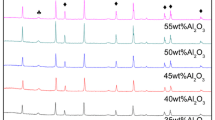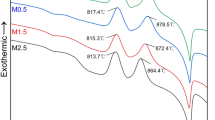Abstract
In this paper, the composites of the TiO2–CaO–MgO–Al2O3–SiO2 glass-ceramic were successfully produced by the method of Sol–Gel from tetrabutyl titanate as the titanium (Ti) source, which were sintering at 1300 °C for 2 h. The dielectric properties of the composites were studied. The highest energy density reached 1.05 J/cm3 with low loss (<0.01), ε = 109 and the breakdown voltage of 48.29 kV/mm, which was 1.38 times higher than that of pure TiO2(0.76 J/cm3).






Similar content being viewed by others
References
C.C. Homes, T. Vogt, S.M. Shapiro, S. Wakimoto, A.P. Ramirez, Optical response of high-dielectric-constant perovskite-related oxide. Science 293, 673–676 (2001)
S. Krohns et al., The route to resource-efficient novel materials. Nat. Mater. 10, 899–901 (2011)
Z.H. Wu, H.X. Liu, M.H. Cao, Z.Y. Shen, Z.H. Yao, H. Hao, D.B. Luo, Effect of BaO–Al2O3–B2O3–SiO2 glass additive on densification and dielectric properties of Ba0.3Sr0.7TiO3 ceramics. J. Ceram. Soc. Jpn. 116(2), 345–349 (2008)
T. Tunkasiri, G. Rujijanagul, Dielectric strength of fine grained barium titanate ceramics. J. Mater. Sci. Lett. 15(20), 1767–1769 (1996)
A. Young, G. Hilmas, S.C. Zhang, R.W. Schwartz, Effect of liquid-phase sintering on the breakdown strength of barium titanate. J. Am. Ceram. Soc. 90(5), 1504–1510 (2007)
J. Liebault, J. Vallayer, D. Goeuriot, D. Treheux, F. Thevenot, How the trapping of charges can explain the dielectric breakdown performance of alumina ceramics. J. Eur. Ceram. Soc. 21(3), 389–397 (2001)
M. Touzin, D. Goeuriot, C. Guerret-Piécourt, D. Juvé, H.J. Fitting, Alumina based ceramics for high-voltage insulation. J. Eur. Ceram. Soc. 30(4), 805–817 (2010)
J.J. Huang, Y. Zhang, T. Ma, H.T. Li, L.W. Zhang, Correlation between dielectric breakdown strength and interface polarization in barium strontium titanate glass ceramics. Appl. Phys. Lett. 96(4), 042902 (2010)
A. Schneuwly, P. Groning, L. Schlapbach, IEEE Trans. Dielectr. Electr. Insul. 5, 862–868 (1998)
X. Zhou, B. Chu, B. Neese, M. Lin, Q.M. Zhang, IEEE Trans. Dielectr. Electr. Insul. 14, 1133 (2007)
C.A Randall, H Ogihara, J.R Kim, G.Y Yang, C.S Stringer, S. Trolier-McKinstry. High temperature and high energy density dielectric materials. IEEE (2009)
N.J. Smith, B. Rangarajan, M.T. Lanagan, C.G. Pantano, Alkali-free glass as a high energy density dielectric material. Mater. Lett. 63(15), 1245–1248 (2009)
H. Ogihara, C.A. Randall, S. Trolier-McKinstry, High-energy density capacitors utilizing 0.7 BaTiO3–0.3 BiScO3 ceramics. J. Am. Ceram. Soc. 92(8), 1719–1724 (2009)
H. Ogihara, C.A. Randall, S. Trolier-McKinstry, Weakly coupled relaxor behavior of BaTiO3–BiScO3 ceramics. J. Am. Ceram. Soc. 92(1), 110–118 (2009)
S.S.N. Bharadwaja, J.R. Kim, H. Ogihara, L.E. Cross, S. Trolier-McKinstry, C.A. Randall, Critical slowing down mechanism and reentrant dipole glass phenomena in (1 − x)BaTiO3–xBiScO3(0.1 ≪ x ≪ 0.4): the high energy density dielectrics. Phys. Rev. B 83(2), 24106 (2011)
R. Singh, S. Alamgir, R. Sharangpani, Deposition of high dielectric constant materials by dual spectral sources assisted metalorganic chemical vapor deposition. Appl. Phys. Lett. 67(26), 3939 (1995)
X. Hao, Z. Yue, J. Xu, S. An, C.-W. Nan, Energy-storage performance and electrocaloric effect in (100)-oriented Pb0.97La0.02(Zr0.95Ti0.05)O3 antiferroelectric thick films. J. Appl. Phys. 110(6), 064109 (2011)
X. Hao, Y. Wang, J. Yang, S. An, J. Xu, High energy-storage performance in Pb0.91La0.09(Ti0.65Zr0.35)O3 relaxor ferroelectric thin films. J. Appl. Phys. 112(11), 114111 (2012)
S. Tong, B. Ma, M. Narayanan, S. Liu, R. Koritala, U. Balachandran, D. Shi, Lead lanthanum zirconate titanate ceramic thin films for energy storage. ACS Appl. Mater. Interfaces 5(4), 1474–1480 (2013)
Z. Hu, B. Ma, R.E. Koritala, U. Balachandran, Temperature-dependent energy storage properties of antiferroelectric Pb0.96La0.04Zr0.98Ti0.02O3 thin films. Appl. Phys. Lett. 104(26), 263902 (2014)
S. Chao, F. Dogan, Effects of manganese doping on the dielectric properties of titanium dioxide ceramics. J. Am. Ceram. Soc. 94(1), 40–50 (2011)
Y. Zhao, X. Hao, Q. Zhang, Energy-storage properties and electrocaloric effect of Pb(1−3x/2)LaxZr0.85Ti0.15O3 antiferroelectric thick films. ACS Appl. Mater. Interfaces 6(14), 11633–11639 (2014)
R. Macklin. Electrostatic energy storage. NASA STI/Recon Technical Report N, 77, 24598 (1976)
Weir et al. Electrical-energy-storage unit (EESU) utilizing ceramic and integrated-circuit technologies for replacement of electrochemical batteries. U.S. 7033406. 25 April 2006
W. Huebner, S.C. Zhan, B. Gilmore, M.L. Krogh, B.C. Schultz, R.C. Pate, L.F. Rinehart, J.M. Lundstrom, High breakdown strength, multilayer ceramics for compact pulsed power applications. 12th IEEE International, vol. 2. doi:10.1109/PPC.1999.823749
T. Tunkasiri, G. Rujijanagul, Dielectric strength of fine grained barium titanate ceramics. J. Mater. Sci. Lett. 15(20), 1767–1769 (1996)
E.K. Beauchamp, Effect of microstructure on pulse strength of MgO. J. Am. Ceram. Soc. 54(10), 484–487 (1971)
G. Mazzanti, G.C. Montanari, F. Peruzzotti, A. Zaopo, Some remarks regarding the test cells used for electric strength measurement. Conference Record of the 1996 IEEE international symposium on electrical insulation, Montreal, vol. 2, pp. 474–477 (1996)
Acknowledgments
This work is supported by the State Key Program of National Natural Science of China (Grant No. 50932002 and 51172035).
Author information
Authors and Affiliations
Corresponding author
Rights and permissions
About this article
Cite this article
Wei, M., Zhang, J., Huang, J. et al. Microstructure and electrical properties of TiO2–CaO–MgO–Al2O3–SiO2 glass-ceramic with sol–gel method. J Mater Sci: Mater Electron 27, 11623–11627 (2016). https://doi.org/10.1007/s10854-016-5294-7
Received:
Accepted:
Published:
Issue Date:
DOI: https://doi.org/10.1007/s10854-016-5294-7




